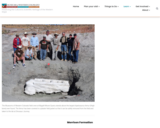
Changing conditions spur a utility in Washington, D.C., to consider and address its future climate vulnerabilitie

Changing conditions spur a utility in Washington, D.C., to consider and address its future climate vulnerabilitie

Students create a concept design of their very own net-zero energy classroom by pasting renewable energy and energy-efficiency items into and around a pretend classroom on a sheet of paper. They learn how these items (such as solar panels, efficient lights, computers, energy meters, etc.) interact to create a learning environment that produces as much energy as it uses.

This hands-on experiment will provide students with an understanding of the issues that surround environmental cleanup. Students will create their own oil spill, try different methods for cleaning it up, and then discuss the merits of each method in terms of effectiveness (cleanliness) and cost. They will be asked to put themselves in the place of both an environmental engineer and an oil company owner who are responsible for the clean-up.

Students explore the concept of biodegradability by building and observing model landfills to test the decomposition of samples of everyday garbage items. They collect and record experiment observations over five days, seeing for themselves what happens to trash when it is thrown "away" in a landfill environment. This shows them the difference between biodegradable and non-biodegradable and serves to introduce them to the idea of composting. Students also learn about the role of engineering in solid waste management.

In this activity, students act as environmental engineers involved with the clean up of a toxic spill. Using bioremediation as the process, students select which bacteria they will use to eat up the pollutant spilled. Students learn how engineers use bioremediation to make organism degrade harmful chemicals. Engineers must make sure bacteria have everything they need to live and degrade contaminants for bioremediation to happen. Students learn about the needs of living things by setting up an experiment with yeast. The scientific method is reinforced as students must design the experiment themselves making sure they include a control and complete parts of a formal lab report.

Examines the collision of politics, economics, values, and science in making and carrying out environmental policy at national, state, and local levels. Case studies of environmental policymaking explore the roles of governmental institutions, business, interest groups, the public, and the media in areas of air and water pollution, hazardous waste disposal, public lands management, and wildlife protection. "Environmental Politics and Policy" explores the workings of environmental policymaking in the United States. What are the big issues facing environmental policy? How did we end up with the policies we have today? Why does it take a crisis to move environmental policy forward? Why do political factors - economic interests, social and political values, bureaucratic styles, ideologies, elections, etc. - always seem to overwhelm sound scientific and engineering judgment in determining policy outcomes? Case studies ranging from cleaning up toxic waste pollution to endangered species protection probe the clashes between science and politics at local, state, and federal levels.

Several activities are included to teach and research the differences between renewable and non-renewable resources and various energy resources. The students work with a quantitative, but simple model of energy resources to show how rapidly a finite, non-renewable energy sources can be depleted, whereas renewable resources continue to be available. The students then complete a homework assignment or a longer, in-depth research project to learn about how various technologies that capture energy resources for human uses and their pros and cons. Fact sheets are included to help students get started on their investigation of their assigned energy source.

12.103 explores the role of scientific knowledge, discovery, method, and argument in environmental policymaking from both idealistic and realistic perspectives. The course will use case studies of science-intensive environmental controversies to study how science was used and abused in the policymaking process. Case studies include: global warming, biodiversity loss, and nuclear waste disposal siting. Subject includes intensive practice in the writing and presentation of "position statements" on environmental science issues.

This course presents a unique and challenging perspective on the causes of human disease and mortality. The course focuses on analyses of major causes of mortality in the US since 1900: cancer cardiovascular and cerebrovascular diseases, diabetes, infectious diseases. Students create analytical models to derive estimates for historically variant population risk factors and physiological rate parameters, and conduct analyses of familial data to separately estimate inherited and environmental risks. The course evaluates the basic population genetics of dominant, recessive and non-deleterious inherited risk factors.

This course emphasizes three methodologies - reliability and probabilistic risk assessment (RPRA), decision analysis (DA), and cost-benefit analysis (CBA). In this class, the issues of interest are: the risks associated with large engineering projects such as nuclear power reactors, the International Space Station, and critical infrastructures; the development of new products; the design of processes and operations with environmental externalities; and infrastructure renewal projects.

This course provides an introduction to the study of environmental phenomena that exhibit both organized structure and wide variability - i.e., complexity. Through focused study of a variety of physical, biological, and chemical problems in conjunction with theoretical models, we learn a series of lessons with wide applicability to understanding the structure and organization of the natural world. Students will also learn how to construct minimal mathematical, physical, and computational models that provide informative answers to precise questions.

This graduate seminar examines the roles that civil society actors play in international, national, and local environmental governance. We will consider theories pertaining to civil society development, social movement mobilization, and relations between state and non-state actors. During the course of the semester, particular attention will be given to the legitimacy and accountability of nongovernmental organizations (NGOs). Case studies of civil society response to specific environmental issues will be used to illustrate theoretical issues and assess the impacts that these actors have on environmental policy and planning.

Addresses relationship between technology-related problems and the law applicable to work environment. National Labor Relations Act, Occupational Safety and Health Act. Toxic Substances Control Act, state worker's compensation, and suits by workers in the courts discussed. Problems related to occupational health and safety, collective bargaining as a mechanism for altering technology in the workplace, job alienation, productivity, and the organization of work addressed. Prior courses or experience in the environmental, public health, or law-related areas.

Introduces students to the theory, tools, and techniques of engineering design and creative problem-solving, as well as design issues and practices in civil engineering. Includes several design cases, with an emphasis on built facilities (e.g., buildings, bridges and roads). Project design explicitly concerns technical approaches as well as consideration of the existing built environment, natural environment, economic and social factors, and expected life span. A large design case is introduced which is used in the subsequent specialty area design subjects (1.031, 1.041, 1.051) and the capstone design subject (1.013).

Introduction to continuum mechanics and material modeling of engineering materials based on first energy principles: deformation and strain; momentum balance, stress and stress states; elasticity and elasticity bounds; plasticity and yield design. Overarching theme is a unified mechanistic language using thermodynamics, which allows understanding, modeling and design of a large range of engineering materials.

Basic philosophy of planning and design of structures. Loads on structures. Design criteria and factors of safety. Design of reinforced concrete structural elements using the ultimate strength design method. Load factor design of structural steel members and connections. Structural system design concepts. Approximate and computational analysis methods. Emphasis on problem-based learning through design project(s) on which students work as design teams. Special topics such as design of cable structures and prestressed concrete structures. Constructability and structural control. This course aims at providing students with a solid background on the principles of structural engineering design. Students will be exposed to the theories and concepts of both concrete and steel design and analysis both at the element and system levels. Hands-on design experience and skills will be gained and learned through problem sets and a comprehensive design project. An understanding of real-world open-ended design issues will be developed. Besides regular lectures, weekly recitations and project discussion sessions will be held.

A survey subject of current concepts, theories, and issues in strategic management of transportation organizations. Provides transportation logistics and engineering systems students with an overview of the operating context, leadership challenges, strategies, and management tools that are used in today's public and private transportation organizations. The following concepts, tools, and issues are presented in both public and private sector cases: alternative models of decision-making, strategic planning (e.g., use of SWOT analysis and scenario development), stakeholder valuation and analysis, government-based regulation and cooperation within the transportation enterprise, disaster communications, change management, and the impact of globalization.

Survey of information technology covering database modeling, design, and implementation with an emphasis on relational databases and SQL. Internet technologies: http, html, XML, SOAP, security. Brief introduction to components and middleware. Introduction to design and implementation of multi-tier architectures, benchmarks, and performance. Data networking protocols and technologies. Students complete project that covers requirements/design, data model, database implementation, web site, and system architecture.

Site characterization and geotechnical aspects of the design and construction of foundation systems. Topics include site investigation (with emphasis on in situ testing), shallow (footings and raftings) and deep (piles and caissons) foundations, excavation support systems, groundwater control, slope stability, soil improvement (compaction, soil reinforcement, etc.), and construction monitoring.

Examines the fundamental concepts of strategic planning and management in the context of the real estate, design, and construction industry. Discusses the basic business relationships among firms in the design and construction value chain. Specific topics include: industry analysis; strategic planning models; information technology strategy; strategy in fragmented industries; negotiation; and macro trends shaping the industry as a whole. Case method of instruction is used, and supplemented by extensive readings. From the course home page: This course provides an overview of key concepts in strategic management in the construction, real estate, and architecture industries. Topics include supply chain analysis, market segmentation, vertical integration, competitive advantage, and industry transformation. This course is of interest to students seeking more understanding of the business dynamics of real estate and construction; seeking to provide value in firms which they may join; or seeking to build a foundation for their own entrepreneurial pursuits.